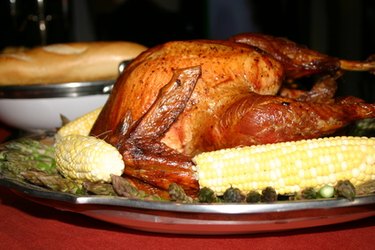Things You'll Need
Large roasting pan
Paper towels
Fryer
Frying oil
Cutting board
Chef’s or kitchen utility knife
Probe (meat) thermometer

The technique of deep-frying turkey originated as part of hog-butchering gatherings that took place in the Louisiana back country in the early 20th century. People rendered the excised fat from the animals into lard and cooked turkeys, as well as geese and chickens, in it. The popularity of deep-fried turkey increased in tandem with the introduction of cooking equipment dedicated to the method, as well as the exposure it received from food-based television networks in the 1990s.
Step 1
Remove the turkey's packaging. Put the turkey in a roasting pan lined with paper towels and place it in the refrigerator to thaw. Allow approximately 24 hours of defrosting time for every 5 lb. of product. Change the paper towels as necessary.
Step 2
If using a fryer or pot without an inscribed oil-fill line, place the thawed turkey in the fryer basket and drop it into the empty fryer or pot. Fill the pot with water until it covers the turkey. Remove the turkey and drain off the water into the pot or fryer. Note the distance of the water crest to the top of the pot or fryer. It should fall within 3 to 5 inches of the top of the pot or fryer. Empty the pot or fryer, wash it and dry thoroughly. Ensure the fryer's spigot, if equipped, is completely dry.
Step 3
Fill the fryer with frying oil to the fill line. Preheat the oil to 375 degrees F if using an outdoor fryer, and 400 degrees F if using an indoor fryer.
Step 4
Rinse the turkey with cool running water and dry it inside and out with paper towels. Moisture creates violently expanding steam when exposed to hot oil, which causes spills. Also, a dry turkey creates an environment conducive to Maillard reaction -- a beneficial chemical process that causes amino acids to caramelize and create a golden-brown color on the surface of proteins.
Step 5
Place the turkey on a cutting board. Remove the turkey's neck and giblets from the front and rear body cavities. Remove any excess fat from the turkey's neck and rear area that might obstruct oil from entering the cavities. Remove any trussing attaching the legs, cut off the tail and remove the wing tips to the first joint. Remove the pop-up timer if present. Allow the turkey to reach room temperature in a clean roasting pan.
Step 6
Cut the heat on the fryer. Place the turkey in the fryer basket and slowly lower the turkey into the oil. Resume the heat on the fryer at 350 degrees F. The temperature of the turkey as it enters the fryer -- in addition to outdoor variables such as the wind -- will lower the temperature of the oil. Maintain the fryer temperature at 350 degrees F by making adjustments as necessary. Allow approximately three to four minutes of cooking time per pound of product.
Step 7
Check the temperature of the turkey by inserting a probe thermometer in the thickest portion of the breast and in the center of the thigh. The minimum internal temperature in the breast should be between 165 and 170 degrees F; the temperature in the thigh should read between 175 and 180 degrees F.
Step 8
Allow the turkey to rest for a minimum of 15 minutes. Proteins reabsorb some of the moisture that mobilizes during cooking, and redistributes it throughout its center during the resting period.
Warning
Always deep fry a turkey from a completely thawed state. Otherwise, the wide temperature gradient between the oil and the turkey will cause the ice crystals to violently expand when turning to steam, creating an explosion.
Check out this related video from ExpertVillage on Youtube
Video of the Day